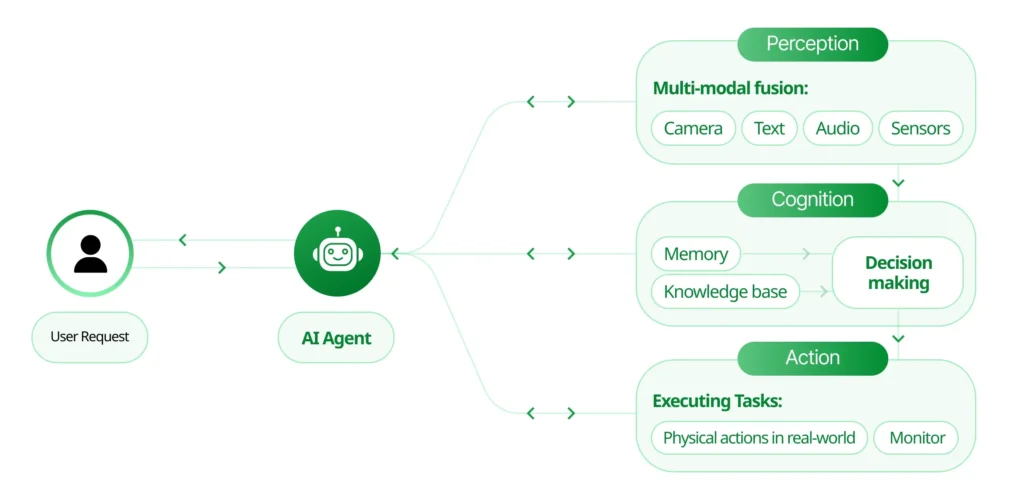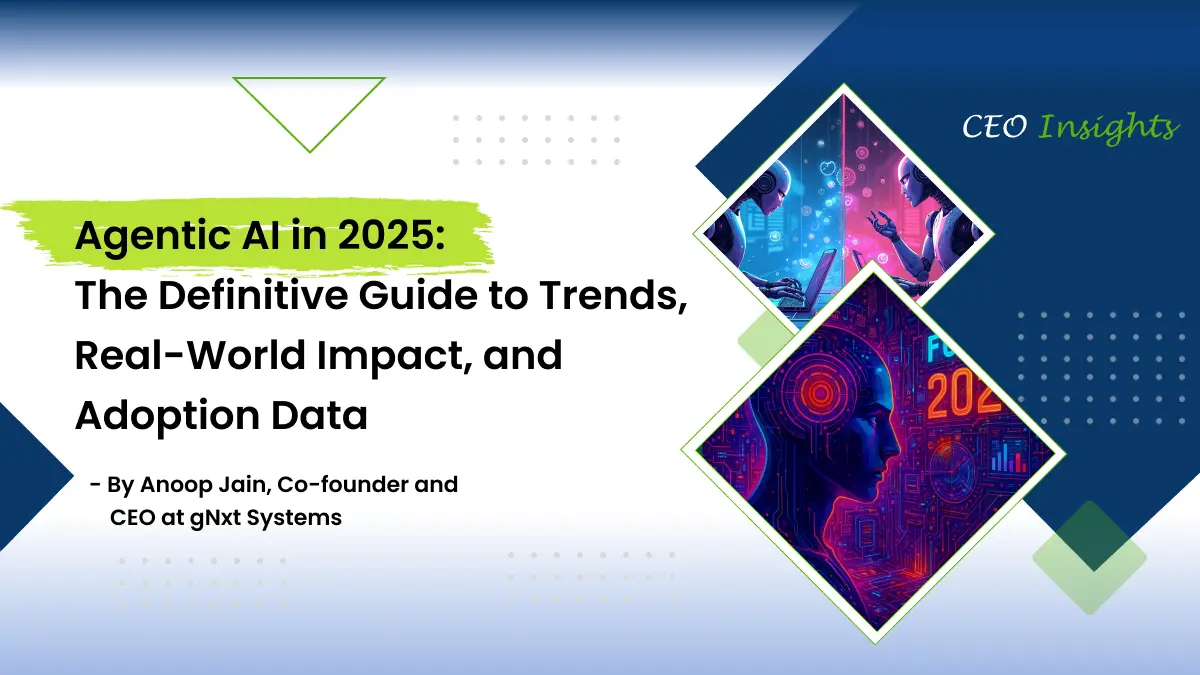- July 23, 2025
- by Anoop Kumar
Agentic AI in 2025: The Definitive Guide to Trends, Real-World Impact, and Adoption Data
Introduction: Why Agentic AI Is the Future of Intelligent Systems
As we progress through 2025, Agentic AI has rapidly emerged as one of the most transformative technologies reshaping industries, digital ecosystems, and enterprise decision-making. Unlike traditional AI models that passively respond to prompts, Agentic AI systems exhibit goal-oriented behavior, proactive planning, autonomous execution, and context-aware adaptation. This shift marks the next evolutionary step in artificial intelligence, moving from reactive to proactive and autonomous agents.
According to McKinsey, by the end of 2025, Agentic AI adoption is expected to surpass 40% in digitally mature enterprises, with deployment in sectors such as finance, logistics, healthcare, education, retail, and software development.
A recent Gartner survey indicates that 56% of AI leaders believe Agentic AI will replace LLM-based assistants by 2026 due to higher autonomy, contextual accuracy, and enterprise alignment.
What Is Agentic AI? How It Differs from Traditional AI

Traditional AI:
- Reactive or prompt-based systems
- Task-specific (e.g., classification, summarization)
- Requires human input for task initiation
Agentic AI:
- Autonomous, goal-directed agents
- Self-initiating and continuously learning
- Plans, executes, and iterates tasks with minimal human involvement
“Agentic AI represents a paradigm shift: from tools to digital collaborators.” — Harvard Business Review, March 2025
Why This Matters in 2025:
- Reduces human-in-the-loop bottlenecks
- Enables scalable decision automation
Improves cross-system orchestration and API autonomy
Top Agentic AI Trends in 2025
1. Enterprise Agent Platforms (EAPs)
Companies are building internal platforms where Agentic AI agents can:
- Manage workflows
- Automate knowledge work
- Collaborate across departments
Examples: Salesforce Einstein, Microsoft Copilot Agents, gNxt Agentic Workflows
2. Multi-Agent Collaboration & Ecosystems
Agent networks are replacing monolithic LLM systems. These ecosystems:
- Share tasks between specialized agents
- Monitor each other’s outputs
- Operate in distributed environments
Data Point: A 2025 IDC report shows enterprises using agent ecosystems saw a 34% increase in operational efficiency.
3. Agentic DevOps and AI-Driven Code Refactoring
Agentic AI tools are now automating:
- Pull request creation
- Code reviews
- Dependency management
Stat: GitHub reports a 63% increase in code deployment velocity using Agentic workflows.
4. Healthcare Agents for Diagnostics and Triage
Hospitals are deploying AI agents to:
- Handle patient intake
- Prioritize emergency triage
- Recommend diagnostic pathways
Impact: Reduced ER wait times by up to 30% in pilot programs.
5. Agentic AI in Retail & Customer Experience
Agents personalize:
- Product recommendations
- Email workflows
- Dynamic pricing engines
Example: Sephora’s AI shopping assistant increased basket size by 22%.
Real-World Adoption Data: Agentic AI in Numbers
Sector | Adoption Rate (2025) | Key Use Cases |
Finance | 48% | Fraud detection, report generation |
Healthcare | 44% | Diagnostics, patient triage |
Retail & E-commerce | 41% | Virtual agents, personalization |
SaaS/IT | 53% | Automated DevOps, agent testing |
Education | 31% | Tutoring agents, grading systems |
Sources: Gartner, McKinsey, Forrester, Deloitte Tech Radar 2025
Adoption Drivers:
- Demand for real-time decision automation
- Rising cost of manual knowledge work
- Availability of no-code agent orchestration tools
Agentic AI Architecture & Deployment Models

1. Agent Planning Modules
Use frameworks like AutoGen, LangGraph, or CrewAI to model:
- Task decomposition
- Goal hierarchies
- Memory and feedback loops
2. Execution Engines
Integrate agents with:
- RPA tools for physical task automation
- API triggers for software orchestration
- Event-driven architectures (EDA)
3. Tool Integration & Environment Awareness
Agents should interface with:
- CRMs, ERPs, and cloud services
- IoT and sensor data (in logistics, healthcare)
- Real-time feedback from users or systems
4. Human-in-the-Loop Safeguards
Use dashboards, alerts, and escalation protocols to:
- Monitor decisions
- Override outcomes
- Ensure compliance and explainability
The Challenges and Risks of Agentic AI
1. Autonomy vs. Control
Too much autonomy without governance may result in untraceable decisions.
2. Explainability & Auditability
Organizations must maintain logs, version controls, and agent reasoning trails.
3. Security Risks
Autonomous agents with API access can become attack vectors if not sandboxed.
4. Bias in Autonomous Decision-Making
Biases in training data may lead agents to make unethical or inaccurate decisions.
Solution: Include fairness checks and human-in-the-loop validation.
The Future of Agentic AI: What to Expect by 2026
- Agent Markets: Public repositories where agents are bought, sold, and reused
- Federated Learning Agents: Sharing knowledge without transferring data
- Emotion-Aware Agents: Personalizing interactions using sentiment and tone analysis
- Regulatory Frameworks: Governments introducing AI-agent standards and sandbox policies
- Zero-shot Multimodal Agents: Capable of reasoning across vision, audio, and language simultaneously
Conclusion: Is Your Organization Agentic-Ready?
The evolution toward Agentic AI is no longer theoretical. It’s a competitive necessity. Whether you’re an enterprise leader, product manager, developer, or digital strategist, understanding and leveraging Agentic AI in 2025 is vital.
- Start with a pilot use case.
- Invest in trustworthy platforms.
- Prioritize transparency and human-in-the-loop designs.
✅ Pro Tip: Want to audit your AI readiness? Click this link to book a 30 minute consultation with our Subject Matter Expert
Read these blogs by gNxt Systems. They might interest you:
Why Every Digital Transformation Strategy Needs AI Agents
The Future is Agentic: Preparing Enterprises for the Next Wave of AI Evolution
What Is Model Context Protocol (MCP) and Why It Matters for AI Developers in 2025
Also click this link to checkout Agentic AI Offerings by gNxt Systems
Agentic AI is autonomous, goal-directed, and proactive, whereas traditional AI is reactive and task-specific.
Yes, especially through SaaS offerings that bundle multiple agents for workflow automation.
Popular tools include LangGraph, Autogen, AgentStudio, CrewAI, MetaGPT, and Open Agents.
Security, lack of explainability, data governance, and integration with legacy systems remain top challenges.
Currently, there are no blanket regulations, but the FTC and NIST are drafting standards for transparency, API logging, and agent behavior monitoring.
Start with a small-scale pilot project using existing platforms. Focus on measurable outcomes, strong observability, and ethical guardrails.
About Author

CEO at gNxt Systems
With 25+ years of expertise, Mr. Anoop Jain delivers complex projects, driving innovation through IT strategies and inspiring teams to achieve milestones in a competitive, technology-driven landscape.


